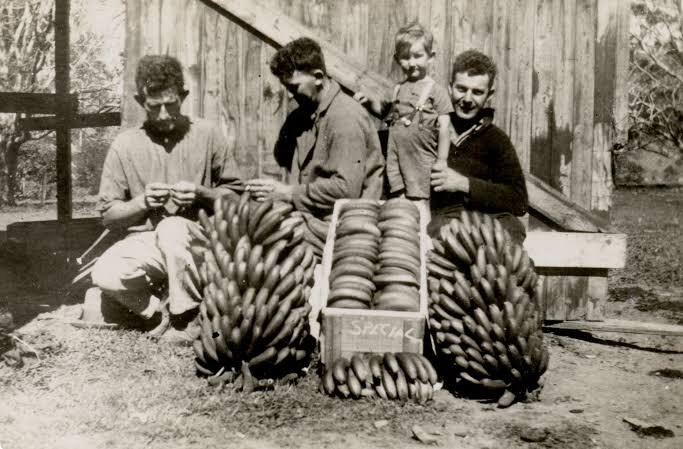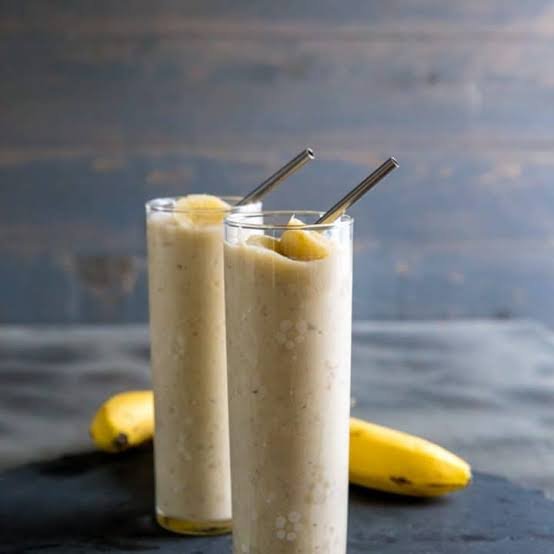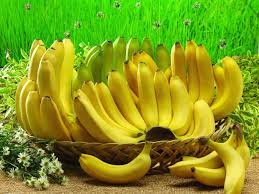My love for bananas made me dug a little bit about its history and benefits. Some of you already had some idea about how banana came to be and its health benefits to humans. Still not everyone knows how great and beneficial eating a single banana can be. So I won't bore you at all with bunch of history instead with this little article, you will be encouraged to make banana your favourite fruit just like me.....lolz
Banana is a term used for the edible fruits produced by various large herbaceous plants in the genus Musa. Botanically speaking, bananas are a type of Berry. They have long slender shape and are covered by a thick skin.
Bananas were brought west by Arab conquerors in 327B.C. Though they were originally found in South East Asia, most especially in India before being moved from Asia Minor to Africa and finally carried to the New World by the first explorers and missionaries to the Caribbean.
 source
source
The first notable disease to strike bananas was a mold called FUSARIUM. Fusarium was also known as PANAMA DISEASE which was carried in the soil. In the 1920s, a second disease struck banana crops called SIGATOSA, which is an airborne fungus.
Before now, in the early years of Central American Banana Trade, the head of UNITED FRUIT had a marriage for political gain to the daughter of the CostaRican President. This surely allowed his fruit company UNITED FRUIT to start acquiring the other fruit companies in the country. In the 1950s when freely elected government of Guatemala threatened United Fruits control, United Fruit convinced the CIA that an overthrow was in order. The CIA placed a right wing dictator loyal to United Fruit in power securing United Fruits Position in Guatemala.
 source
source
In the same 1920s, United Fruit pathologists found that they could spray the plants with a BORDEAUX MIXTURE, a pesticide and it did control the Sigatosa. They couldn't do the same to the disease "Furasium" but they developed a strategy to control Furasium by moving banana plantations every ten years or so. Later, researchers developed a banana that was immune to Furasium, the Giant Cavendish (ok, let's stop here for history)
In Western cultures, the term "banana" usually refers to the sweet yellow variety. The outer skin is green, tough and difficult to peel when unripe. As the banana ripens the skin changes to bright yellow, followed by a dark brown and becomes more easier to peel. Bananas can be eaten raw and their edible flesh becomes sweeter, darker and softer as it ripens. They can also be enjoyed cooked when ripe, often in desserts. When green, they can be boiled and mashed and eaten as you would mashed potatoes.
Bananas are incredibly convenient, healthy, delicious and of the most inexpensive fresh fruits you can purchase. They contain many essential nutrients and may benefit weight loss, hearthealth and digestion. Now you will see some wonderful health benefits of this lovely fruit and keep them around you all the time.
Banana is said to improve blood sugar levels because it is rich in soluble fiber. During digestion soluble fiber dissolves in liquid to form a gel. This is also what gives bananas their sponge-like texture. Unripe bananas also contain resistant starch which is not digested by your body, together these two types of fiber may moderate your blood sugar levels after meals.
Bananas are said to help weight loss, they have several attributes that could make it a weight-loss-friendly food. Bananas have relatively few calories. The average banana has just over 100 calories yet it is nutritious and belly-filling. Eating more fiber from vegetables and fruits has repeatedly been linked to lower body weight and weight loss. Unripe bananas are packed with resistant starch so they tend to be filling and reduce your appetite.
Bananas are rich in nutrients, they contain some amount of fiber and several antioxidants. One banana may contain the following nutrients below:
Calories 112
Fat 0 gram
Protein 1 gram
Carbs 23 grams
Fiber 3 grams
Vitamin C 12% of the daily value(DV)
Riboflavin 7% of the DV
Folate 6% of the Dv
Niacin 5% of the DV
Copper 11% of the DV
Potassium 358mg
Magnesium 21mg
One banana provides about 112 calories and consists almost exclusively of water and carbs. They hold little protein and no fat. The carbs in green Unripe bananas are mostly in the form of starch-- a type of indigestible fiber. As the fruits ripens, its flavor becomes sweeter while its fiber content drops.
Bananas makes you feel fuller, the soluble fiber in bananas may help keep you full by adding bulk to your digestive system and slowing digestion. Bananas are relatively low in calories for their size. Now when combined, the low calorie and higher fiber contents of bananas make them a more filling snack than other foods like processed or sugary boxed snacks.
Bananas may improve kidney health, Potassium is vital for healthy kidney function and blood pressure regulation. As great dietary sources of Potassium, bananas could be especially beneficial when it comes to keeping your kidneys healthy.
Bananas may support exercise recovery, they are sometimes referred to as the perfect food for athletes. This is largely due to their content of easily digested carbs as well as the minerals (Potassium and Magnesium) both of which act as electrolyte. Electrolytes are lost through sweat during vigorous exercise. Resupplying your body with Potassium and Magnesium after sweating (eating a banana) may reduce exercise related muscle cramps and soreness. These will just be few of the health benefits I will write here.
Can Banana be a component of your food or drinks? Yes ofcourse....
Bananas can as well be added to your diet instead of eaten alone. They make a great addition to yoghurt, cereal and smoothies and they work a treat as a topping on a whole grain toast with peanut butter. They can even be used in place of sugar in baking and cooking. (O My, I love the combination of bananas and rice)
Well, here are some few drinks that lovely bananas compliment a lot and without them they would be incomplete drinks or smoothies I would say.
Tropical smoothie (ice cubes, chopped papaya, frozen BANANAS, coconut water, fresh lime juice, Pineapple etc)
Green Tea Banana smoothie (lipton green tea, BANANAS, breyers,natural vanilla ice cream)
Banana Berry smoothie (BANANAS, Greek yoghurt, heavy whipping creme, ice cubes, vanilla etc)
Unicorn smoothie (Greek yoghurt, BANANAS, sprinkles,low fat milk, whipped creme etc)
Green smoothie (Greek yoghurt, ice cubes, honey, large frozen BANANAS, kiwis, large kale leaves etc)
Apple pie smoothie ( nutmeg, gala apple, cinnamon, unsweetened almond milk, frozen BANANAS etc)
Banana boat ( BANANAS, milk, creme, Pineapple juice and vanilla syrup)
 source
source
Banana peanut butter, a protein smoothie ( peanut butter, hemp seeds, unsweetened almond milk, BANANAS, cayenne pepper etc)
Cranberry blueberry, fruit smoothie ( large frozen BANANAS, frozen blueberries, silken tofu, pure unsweetened cranberry juice)
Strawberry and Hezelnut juice, Marmita (water, brown sugar, hazelnuts, mintleaves, BANANAS, strawberries etc)
Bananas and Plantains may look similar and have some common nutritional benefits, but still they are different in what they contain. Since I have mentioned previously the nutrients in bananas, I will list the same on plantain and you can tell the differences even though they are a bit similar.
Plantain contains the following:
Calories 122
Carbs 32 grams
Fiber 2 grams
Potassium 487mg
Magnesium 36mg
Vitamin C 18mg
The main difference is that more of the carbs in bananas come from sugars, whereas more of the carbs in plantains are from starch.
This is where I will draw the curtain on my little research of my best fruit and I hope you enjoyed it. Please do leave a comment, they encourage me a lot. Thank you Hive community.
